Kerala, located in the southwest part of India, on the coast of the great Arabian Sea, became a famous and accessible port to many foreign invasions. Cultures like French, Portuguese, Dutch, British, and even Arabs came into the country through this part of the land. Therefore, their traces are yet seen in the culture, the cuisine, and especially in the historical monuments of Kerala. These monuments stand as a testament to the diverse influences that shaped the region, offering a unique blend of European and indigenous architectural styles that make Kerala’s historical sites truly remarkable.
The state, widely known for its tourism, is therefore not limited to its natural beauty or temples. The heavy French, Portuguese, and British influence in this part of India inspired many architectural monuments and buildings in this region.
Explore Historical Monuments of Kerala – that Will Make You Feel Like You’re in Europe
Join us on this trip to Kerala, far away from the Kerala we know!
1. Tellicherry Fort

Also known as Thalassery Fort, it is located in Thalassery, Kerala. Built on the side of the Arabian Sea, this 18th-century-built monument provides a stunning view of the vast, wide blue. The fort that was once the nucleus of Thalassery’s development lies in ruins now. One of the most important European trade centers in Kerala, Thalassery first came into contact with the French. However, by the end of the 17th century, the British arrived and established a factory here, marking the beginning of their influence in the region. The impact of these encounters can still be seen today in the Historical Monuments of Kerala, particularly in Thalassery, where the blend of French and British architectural styles is evident
This 10-meter-tall fort (Tellicherry Fort) made up of laterite blocks was built by the Britishers to safeguard their trade activities from the attacks of the local chieftains. It is a fairly preserved fort depicting the fine blending of Indo-British architecture!
2. ANCHUTHENGU FORT
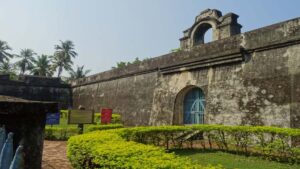
Anchuthengu, Kerala, was the first permanent port of the British East India Company, established in 1699 to facilitate smooth trade. The construction of this fort is a prime example of the historical monuments of Kerala, reflecting a unique blend of European and Indian architectural styles while maintaining its colonial aura. Tourists are drawn to this fort for its scenic surroundings and sea-facing location. The smell of rust mingled with moss and sea salt creates an engulfing atmosphere, leaving a lasting impression on visitors.
The fort’s weathered walls and bastions reflect the history of British colonization of India and is now under ASI for its restorations and renovations.
3. FORT KOCHI

The historic city of Fort Kochi is one of the most loved places among tourists for its European culture and history, including the colonial history of the Dutch, British, and Portuguese. The iconic Fort Kochi Gate, St. Peters Church by the Dutch, and many Dutch bungalows, warehouses, and other Dutch-inspired architecture are the main attractions of this land.
This historical place in Kerala is a specific neighborhood in the larger city of Kochin, and it takes its name from the first European fort on Indian soil, Fort Manuel. To gain a wider perspective of the Dutch colonies and their history and architecture, Fort Kochi is the place!
4. THOMAS FORT
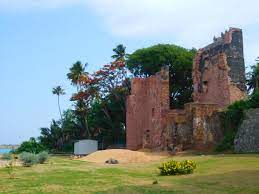
The town of Tangasseri was at first associated with Chinese trade; however, later it was colonized by the Portuguese, Dutch, and British. This fort was built by the Portuguese under Afonso de Albuquerque in order to protect the newly developed trade. Although the trade was established in 1505, the building of this fort in 1518 established the hierarchy of the Portuguese.
This historical monument of Kerala Fort was passed down hand in hand from the Portuguese to the Dutch in 1661 and from the Dutch to the British in 1795. Now completely in ruins, there’s not much to see; however, the Archeological Survey of India has taken it under for its restoration.
5. Franz Church, Kochi
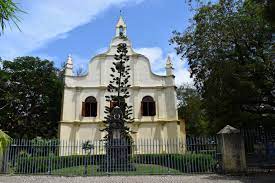
Built in 1503 by the Portuguese, it is the oldest European-built church in India. Later, the church was renovated and expanded under the Dutch and British, incorporating their architectural styles into its structure. This church is one of the notable Historical monuments of Kerala and was originally the burial ground of Vasco da Gama, the famous Portuguese explorer who died in 1524 on his third visit to India.
The exterior of the church is plain white, while the interior is elegant, with stained windows and wooden decorations.
Vasco da Gama’s remains were later shifted to Jeronimos Monastery, Lisbon, Portugal; however, his original tombstone was here on this land.
6. BOLGATTY PALACE

The palace was originally built by the Dutch in 1744 as a residence for their governors. Later, the British came in and took over it, making it their summer resort and for other official works. The wooden roofs, the ornate designs, and the long Keralan verandah explain the fine mix of Dutch and Kerala-style architecture. Bolgatty in Kerala is an island surrounded by the backwaters of Kochi, hence making the surrounding area picturesque!
The palace is now transformed into a luxurious heritage hotel with fine dining and scenic surroundings.
Tourists often visit this historical monument to witness its beauty, enjoy luxurious stays, and embark on boat cruises, all while immersing themselves in the rich history of this site. Cheers to this magnificent part of the historical monuments of Kerala!
7. MATTANCHERRY PALACE
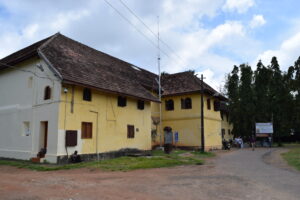
Also known as the ‘Dutch Palace, this historical fort is located in Mattancherry, Kerala. Originally built by the Portuguese in 1555, it was later renovated by the Dutch, hence the name. A gift to the King of Kochin, this historical place showcases a unique blend of Portuguese, Dutch, and even Keralan beauty.
The fort has a courtyard in its center with large buildings surrounding it. The buildings consist of a coronation hall, a throne hall, a bedroom, and now a museum showcasing the history of the fort.
A must-visit destination, Fort Mattancherry should be on your list for your next visit to Kerala.
8. JEWISH SYNAGOGUE- Famous Historical Monuments of Kerala
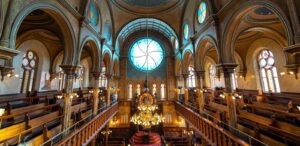
A synagogue is a building or place of meeting for worship and religious instruction in the Jewish faith. Also known as Pardesi Synagogue, this colonial building in Kochi offers beautiful features and intricate detailing, reflecting the Jewish culture and their history in India. The multicolored window glasses bring in the most beautiful reflection of sunrays you would have laid your eyes upon!
The wooden pulpit and the grand chandeliers are some of the most eye-catching, adding to the elegance of the synagogue. Kochi had a thriving Jewish community with Jewish traders, resulting in the building of this synagogue.
Fact: It is the oldest synagogue in the Commonwealth, being built in 1568, and follows a Dutch style of architecture.
9. Gundert bungalow
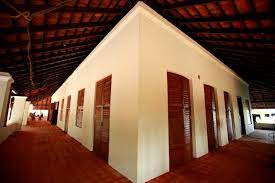
You might be amazed as to why a residence is titled as a monument. Well, this bungalow is more than merely a place to live! The walls of this bungalow resonate with history in their own language. Home to Dr. Herman Gundert, a German scholar and lexicographer, this typical colonial-style mansion has witnessed some of the greatest research in classic Indian literature and the birth of a new dictionary. A legit dictionary!
Dr. Gundert spent his time learning Malayalam and later published the very first daily newspaper in Malayalam, ‘Rajyasamacharam’, the first Malayalam magazine, ‘Paschimodayam’, and even the first Malayalam-English dictionary in this bungalow itself.
Visit this architectural grader in Thalassery and breathe in the birth of some of the greatest works of Dr. Gundert!
Check out our blog to know /11-historical-temples-of-south-india/
CONCLUSION
These historical monuments of Kerala contribute to the state’s rich cultural heritage and history with respect to the different colonizations. The Dutch, Portuguese, and British all left their mark on Kerala’s architecture, resulting in hybridization. The markets, the cuisines, the houses, and even the traditions in some places still resonate with this hybridization.
To learn about more interesting monuments and facts, visit https://itihaaskikhoj.in/

